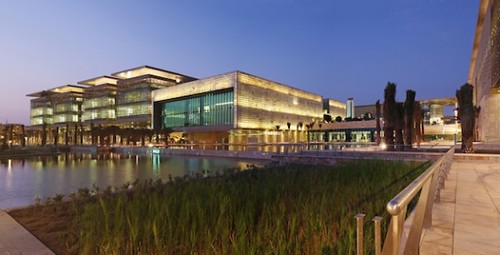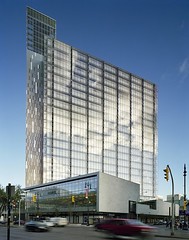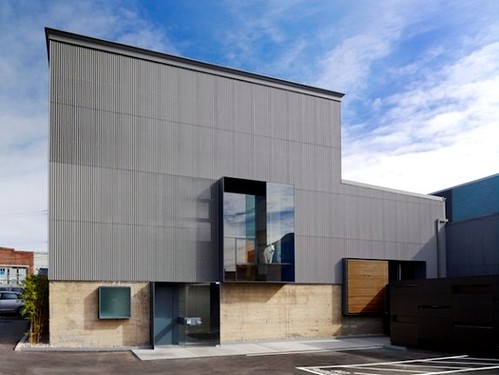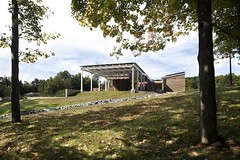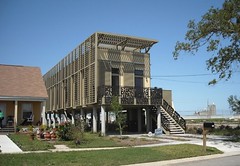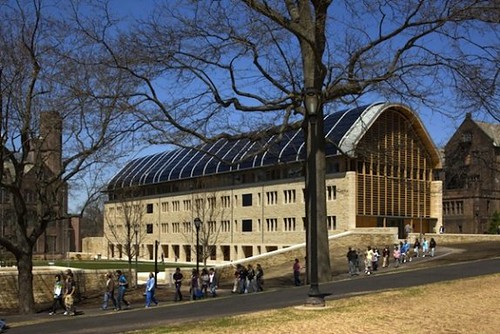I wish AIA didn’t define ‘green’ so narrowly

Posted April 28, 2010 at 1:34PM
The American Institute of Architects has announced its top ten green projects for 2010. Sponsored by AIA’s Committee on the Environment, the award winners are each worthy of citation for excellence in internal design, in most cases reducing their environmental impacts significantly below those of similarly located but conventional buildings while also serving as teaching exemplars. So far, so good.
But what they don’t do – or, if they do, it is generally accidental – is help shape the form of their communities in a way that further reduces impacts below those addressed by the buildings themselves. I’ve questioned AIA before on this count. We know from research that where we put a building can have a bigger impact on the environment than how we design it, through transportation emissions and the impacts related to associated neighborhood infrastructure. Even the ‘greenest’ building (judged internally) will hurt more than help the environment if it is placed in sprawl or an otherwise unwalkable location.
In other words, my view is that sustainable architecture is only worthy of the name if it is in the right places, and includes design that respects and enhances the community around it, including neighborhood walkability. I would expect the most award-worthy green architecture also to include great public spaces, be placed on well-connected and pedestrian-friendly streets, include superior public transportation connections, attain densities that support efficient use of land, and contain mixed uses in multi-building projects. The best LEED-ND projects – such as Vancouver Olympic Village or Station Park Green, for example – do all of this, and they are designed by architects, as are the buildings within them. (Watch this space tomorrow for an announcement on LEED-ND, by the way.)
But AIA chooses instead to focus on the buildings themselves (and, to an extent, their lots). That only gets you so far.
This year’s winners include the following:
- A strikingly contemporary approach to historic district architecture in San Francisco, which looks stunning as sculpture but appears to front onto a parking lot and presents a mostly blank wall to the visitor;
- A low-rise trophy building that has been certified LEED-platinum within a university in Saudi Arabia;
- One of Brad Pitt’s Ninth Ward houses that without question addresses worthy goals but dwarfs its traditional neighbors and, to me, looks on the outside like nothing so much as small-scale ‘starchitecture’ with some NOLA ornamentation slapped on;
- The sprawling City of Watsonville Water Resources Center;
- A contemporary mixed-use tower in Portland, with windmills on top;
- The very remotely located Omega Center for Sustainable Living (Walk Score: eight out of 100) near Rhinebeck, New York;
- Kroon Hall, which houses the Yale School of Forestry;
- Another contemporary tower, housing the main energy utility for the province of Manitoba;
- An elementary school campus in suburban Manassas Park, Virginia;
- The Homer Science and Student Life Center at Sacred Heart School in Atherton, California;
I want to stress that I am not arguing that these are bad projects. I like some of them quite a bit, and I'll concede that a concept like the Omega Center has attributes that would be harder to realize in a city neighborhood. But fully six of the ten are institutional buildings; only one is residential; the architectural style consists only of degrees of contemporary, though Kroon Hall to its credit has significant neo-traditional elevations (a brownfield redevelopment, Kroon Hall may also be my favorite).
While some of the winners do appear likely to be in walkable, transit-served urban environments, that does not seem remotely to have been a criterion in AIA’s awards selection. In fact, the words ‘transit,’ ‘transportation,’ ‘sidewalk,’ and ‘neighborhood’ do not appear once in AIA’s descriptions of the ten winners. ‘Transit’ does appear in the general introduction, but it does not appear significant enough to be a descriptor of any of the individual honorees; ‘community’ appears only twice, once in the context of Sacred Heart School’s ‘learning community,’ and once in a vague allusion to attributes of the King Abdullah University of Science and Technology. Are not these things part of what determines whether our built environment is truly green?
I suppose AIA might argue that the jury was only interested in evaluating what the architects influenced, and the surrounding contexts were beyond their control. But architects influence neighborhood-scaled projects as much as institutional ones, and some rise greatly to the challenges of fitting into an urban setting in a way that faciliates public life and community sustainability, not just building sustainability, while respecting the neighborhood. Given that these are the projects that perform the best environmentally, they deserve to be highlighted every bit as much as the ones that were selected, and I can make a strong case that they are even more worthy.
I know that there are leaders in AIA who get it. Vivian Loftness (a past chair of the committee on the environment), David Dixon, and Bill Roschen have all held prominent positions in the organization and have all championed the consideration of community context in defining what is ‘green’ about architecture. The Institute maintains a Communities by Design staff that does great work assisting these values. (I try not to read too much into the fact that the CxD team’s advisory committee, which included yours truly, was abolished, but the fact is there.) I don’t know where the smart growth movement would be without architects; they have been our friends and mentors from the beginning.
So I don’t quite get why so few of these award winners are exemplars not only of great building and on-site design but also of urbanity, walkability, location efficiency and community enhancement.
You may visit a gallery of the winners on the Fast Company site.
